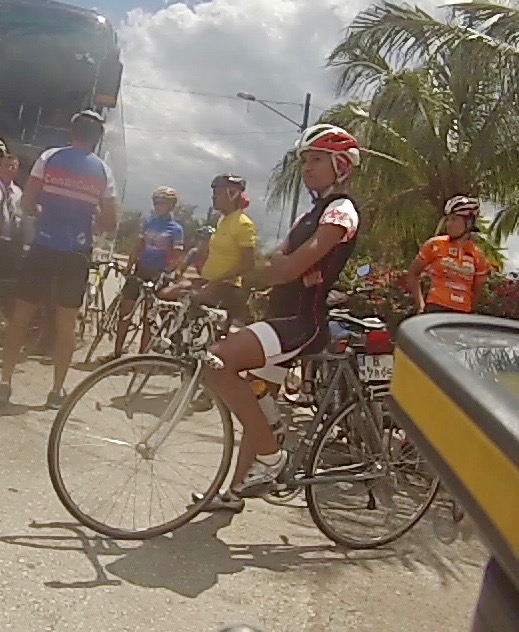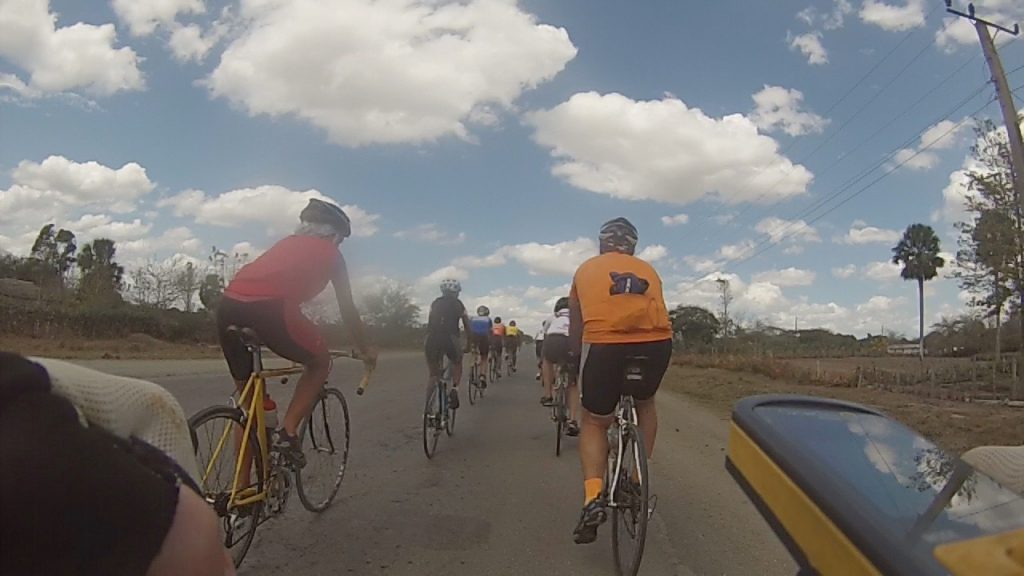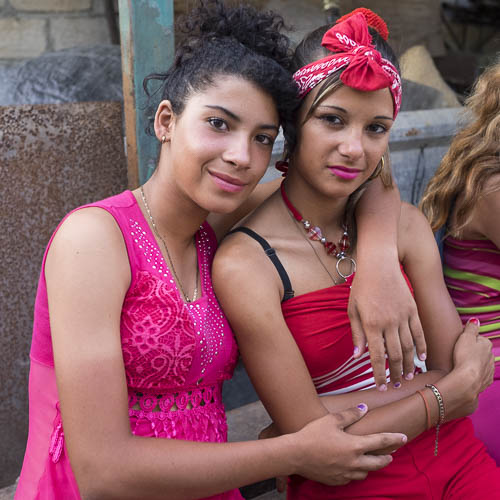We left Bayamo, The City Of Horse Carriages, mid-morning after driving from the carriage factory to the outskirts of town. Juan pulled into the “terminal” – a dusty wedge in a Y intersection – of Las Mangas. We milled around, checking bikes, sharing rumors. Today, in anticipation of our rendezvous with the local junior cycling team, we were all in our matching Cuba bike shirts.
Alejandro announced, “OK, today we ride with the cycling team, from Las Tunas. We meet them at Vado del Yeso.”
“Vado del Yeso…Vado del Yeso…” I mumbled over and over to myself. Cuba is bereft of signage, even the largest cities identified with a modest 2 foot long blue city limits sign on the way in. When leaving, there was always its sibling, the town name with a red slash through it, saying, “It’s all over now, Folks.” They were easy to miss.
Vado del Yeso was about 30 kilometers away – a little over an hour at our pace. We were aided by the constant tailwind we enjoyed traveling east to west, and the ever-so-slight downhill the whole way. Our pace line made quick work across the crusty pavement, beneath the floating puffy clouds lining the horizon, enhancing the cotton-soft feel of the tropical low land air.
In Vado, we pulled off to the left, and waited for our slower companions, our bus, and the local team. Naturally, this required at least 4 Bucaneros shared by three of our riders. I was the designated driver, so I refrained. As more cyclists filled the lot, it became apparent that the team was … all girls. All teenagers. Young and vibrant, glowing in their varied kit, mostly donated from the States. Our beer-drinking pace line snuck back to the toilet. By the time we returned, the bulk of the group had already headed down the road. Not wanting to be dead last, I jumped on my bike, and turned on my camera.
The road turned from a gentle downhill to a false flat, every so slightly rising 100 meters over the final 32 kilometers. I saw a lean rider streak by me on the left – clearly not one of ours, she wore a dark shirt, and seemed on a mission to catch the front of the group. To my side, I noticed another young cyclist creeping up. She started asking me questions, in Spanish. I tried my best to explain how little I understood, but she persisted, She also stuck with me for the next few kilometers, until it finally dawned on me that she had been assigned to me. Each of us, apparently had our own minder, who was going to ride, however slow or fast with us the whole way into town.
I sped up; she sped up. I tried to catch the folks in front of me; she half-wheeled me into the pavement. It was frankly a bit embarrassing to be trying my hardest, and have this little spit of a kid keeping pace, waiting for me to actually get going.
I looked around frantically for a way out of this. I like riding in silence; I’m not one of those chatting roadies, who can’t shut up while pedaling. I tried explaining (in the meagre Spanish at my disposal) that my wife was behind me, and I would wait for her. I told my minder to go on ahead. She seemed to understand, and reluctantly rode off.
In less than two minutes, Cheryl rolled up, her bright orange vest hiding the “Cuba” emblazoned on her white cycling jersey, her cute little cycling skirt fluttering about her thighs.
“Thank God you’re here!”
“What?”
“Well, didn’t one of the girls ride with you?” I asked.
“No, I was the last one to leave I guess. I looked up, and everyone was gone!”
“I think each of the girls is riding with one of us. I tried talking with mine, but couldn’t get a mutual understanding. Maybe she’d rather ride with you. You can at least understand a little Spanish. You’ll like it – she just wants to go your speed, take you into town.”
We negotiated briefly, made the exchange, and off I went. Within minutes, I caught up to a clutch of our slower cyclists, each riding with his or her own minder. Flowing along two-by-two, they filled the entire lane of the narrow Cuban highway. No matter, as usual, they had no competition for the space, and the few trucks out driving moved all the way over into the opposite lane, confident no cars were coming for miles anyway.
The group looked a little stressed – it was over 30 C, and they seemed starting to melt. I zipped up to the head, and offered what little help I could with my puny draft. At 12 mph, up a hill, with a tail wind, I think it was more psychological than anything else. But we all got to the top together, and cruised in the last few miles to town.
At the hotel, Alejandro encouraged us to collect all the donations we had brought for the team. We piled in an eclectic collection of bike parts and uniforms: cranks, stems, chain rings, cassettes, lubes, bibs, shirts, socks, tires, tubes, spokes and assorted tools. We jammed it all into the largest duffel bag we had, and headed out to the bus.
Juan expertly moved left and right along the impossibly narrow lanes depositing us at a gated driveway in the middle of a warren of two story concrete homes. Music blared from the back yard, wafting along with smoke from a giant barbeque pit. We trundled out of the bus and through a rusted iron gate. To our left, on a small concrete patch covered by a corrugated metal roof, a wrinkled grey-haired woman, crooked with age, slowly rocked in a wicker chair. To our right, a narrow path guided us around back. There, an entire pig was slowly turning on a spit, constantly basted by an attentive chef, who had also been the girls’ coach.
They had transformed themselves from determined young athletes – they boasted the Cuban junior women’s champ among them – into shy and giggly teen-aged girls. Scrubbed and brushed and slithered into short shirts and scanty tops, they could have been out for a night on the town. Instead, they had to party with a bunch of geriatric sun-burnt cycling bums from the USA.
We opened up the duffel, and proudly displayed our motley collection of hand-me-downs. Given the onerous import restrictions in the Cuban economy, this was better than Christmas for the cycling team. They modestly acknowledged our gifts, and started discreetly fighting over who would wear what jerseys; size appeared to matter less than audacious color schemes.
We toasted each other with fruit juice (for the girls), ron and Bucaneros (for the old goats), and vowed eternal friendship. Large slabs of pork were handed all around, along with piles of bread and salad. I don’t know if they ate this way every day, but it’s certainly possible, given how hard and long they seemed to cycle – their ticket to another world, maybe, which drove them so hard.
Our party barely fit shoulder to shoulder in the tiny patio back behind the squat socialist-issue concrete house. The food was swept away, more drinks appeared, and a boom box cranked up with driving island beats. The girls swayed, some of our crowd actually danced, and somehow the group no longer seemed incongruous. Just a bunch of peole who liked to bike, have a good time, and party on a tropical isle. The Cubans didn’t seem to mind either us or the cramped quarters. Their eyes lit up the night, and their laughter echoed towards us as we filed back onto the bus, promising to guide us out of town the next morning.




1 Response to Las Tunas Junior Cycling Team